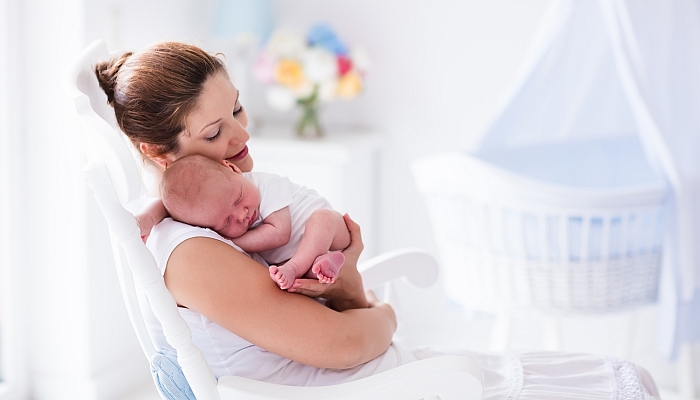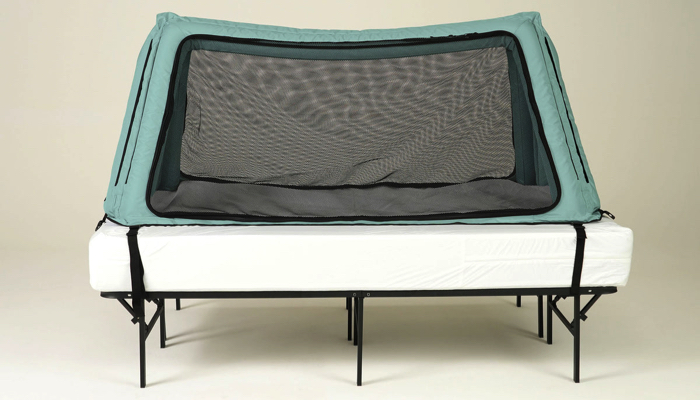Gentle Sleep Training: No-Cry Methods for Better Sleep

- Gentle Sleep Training is used to teach a baby to self-soothe with minimal to no crying involved.
- Babies 3-6 months old are at a good age to begin sleep training.
- Some babies are sleep trained within a couple of days.
- There are several “No-Cry” methods to choose from.
- Parents report improved sleep for them and their baby 5 months post sleep training.
2:13 am – “The baby is awake again!” I mumble to myself
“He’s 4.5 months old. I thought for sure he’d be sleeping through the night by now! I am so tired. I just can’t keep doing this anymore.”
I catch myself thinking these things as I sludged across the floor to pick up my crying baby in his crib. Up to this point, he had only slept through the night a few times in his life. I was a new mom and had no idea how to change our routine.
I nursed him to sleep and then slipped him back into his crib, only to be awakened in a few hours once again. I knew he didn’t need to eat. He had eaten plenty throughout the day. This was just a pattern we had gotten into and I saw no way out.
The next day, I was speaking to my older sister about how she managed sleepless nights and she then introduced me to the world of gentle sleep training.
What Is Gentle Sleep Training?
Gentle sleep training is any method taken to gently usher your child to fall asleep independently with little to no crying. The goal is to change what you do so slowly that your baby adapts to the change with little disturbance.
Previous generations used a harsher approach when putting babies to sleep. It was believed that crying was good for a baby’s lungs and they encouraged mothers to leave their small babies alone in a crib to “figure it out”.
We know now that self-soothing is a skill that can be taught and some children need more intervention to learn to self-soothe than others.
Falling asleep independently is not something that comes naturally to young children so creating good sleep habits and incorporating self-soothing skills can be a much gentler and more effective way of helping your child.
Below is a list of the most common gentle sleep training methods.
- Fading Method – Requires the caregiver slowly “fade” themselves out of the baby’s sleep routine by gently reducing the amount of time and involvement they spend with her as she falls asleep.
- Chair Method – The baby is placed in the crib drowsy but awake and the caregiver sits in a chair next to the crib, offering reassurance. Slowly the caregiver will move the share further away from the crib as they watch the baby fall asleep.
- Pick Up Put Down Method – The parents pick up the child when they get upset but quickly place them back down in a sleep position and say something like “it’s time to go nigh-nigh”. The parents will continue to do this until he falls asleep.

When Should I Start Gentle Sleep Training My Baby?
You’ve decided on a sleep training method but now you’re unsure of when to start.
There are two things to consider before beginning sleep training:
- The age of your baby
- The health of your baby
The Age of Your Baby
Most sleep experts believe that the best time to sleep train is when your baby is between the age of 3-6 months. Typically by this age, babies’ brains have developed to the point they can effectively learn to self-soothe.
They also are old enough to go the whole night without feeding, assuming their weight gain is on-trend.
The Health of Your Baby
If your baby has any underlying medical issues, you may want to discuss them with your pediatrician before beginning gentle sleep training. Some children may take longer to reach the developmental point in which self-soothing is possible.
Other children may also need nighttime feedings due to slow weight gain or other nutritional deficiencies.
How Does Gentle Sleep Training Work?
Sleep training works because of classical conditioning. Classical conditioning is a form of automatic, associated learning discovered by the Russian psychologist, Ivan Pavlov. It works by consistently presenting a neutral stimulus (in this case, sleep routine) with an unconditioned response (sleep).
With consistent and repeated exposure, eventually, the response (sleep) will begin to be conditioned to the stimulus (sleep routine).
So in simple terms, sleep training teaches a child to sleep by associating sleep with triggers other than a parent.
A solid nap and sleep routine are required for any gentle sleep training to work. If you are not consistent with the routine before sleep, it will interfere with your baby associating the triggers for independent sleep.
You are not only focusing on sleep during the night, but you will be sleep training for naps as well. This is something to consider when choosing which training method you want to use. You may be able to commit the time to “pick up, put down” at bedtime, but will you be able to put in the same effort during the daytime for naps?
It is important to pay attention to your baby’s sleep patterns. All children have a natural sleep rhythm and paying attention to their cues will tell you when it’s best to begin your sleep routine, just adding to the effectiveness of the training.
Creating a Sleep Routine
A sleep routine, sometimes called a bedtime routine, can help your baby sleep better and lessens the chances of bedtime problems.
For example, our bedtime routine looks like this:
- Put on pajamas.
- Read three small books with Mommy and Daddy.
- Say “Nigh-nigh” to Daddy.
- Sit in the rocking chair, and cuddle with Mommy and “Lovey” in the dark room while Mommy sings the bedtime song.
- Place in a sleep sack and then in the crib, drowsy, but awake.
Start by choosing an appropriate bedtime.
What time you choose will be dependent upon several things:
- Your baby’s age
- How much time does she spend napping during the day
- How much time has passed since her last nap
- What works with the family’s schedule.
For my family, we found that making sure there was an appropriate distance between when they stopped napping and when they went to bed worked best for us. We had to ensure our baby was awake long enough to be appropriately sleepy before attempting to begin our sleep routine. This meant getting him to nap early enough and sometimes meant waking him from his nap if he began to sleep too long.
Research has provided a reference for how much time a child should be sleeping as well as how much wake time they need. The amounts are dependent upon your baby’s age and health.
Determine what items you’d like to include in your bedtime routine.
Examples are:
- Books
- Songs
- Bathtime
- Massage
- Cuddle/rocking time
Choose items that will be low stimulation for you and the baby. Trying to put an overstimulated baby to bed is no fun!
Include attachment objects (if age appropriate).
Examples could include favorite blankets, “Lovies”, pacifiers, and/or stuffed animals
Attachment objects can be very comforting to a baby who is sleep training. Place the attachment object in their hands or wrap it around them while they are feeding or reading books. Then when it is time to place your baby into the crib the object goes with them, which helps make the transition more peaceful.
You may even consider sleeping with the attachment object a few days before sleep training begins. If your baby can smell you, they are more likely to remain calm when you leave the room.

Pros of Gentle Sleep Training
Your Baby Will Learn to Self-Soothe
Your baby’s ability to self-soothe will help your whole family get consistent sleep. In one infant sleep study, when parents used a gentle sleep training method they reported up to 30% improved sleep five months later.
Although, it also appears this improvement is time-limited. Many parents found by age two the benefits had worn off. Two years of good sleep is still a positive mark for sleep training though!
Better Sleep Increases Cognitive Function
Sleep is where the magic of physical and mental growth happens. When the body is resting, the brain is processing all the new and exciting things your baby learned during the day, making room for more growth when she wakes up!
Getting adequate sleep not only promotes brain growth but also helps boost the immune system.
Results Can Occur Quickly
Although it may take a couple of weeks, many families find sleep training to be successful within a few days. I know for our oldest son, we had two rough nights as he transitioned to the new routine but by night three he had it down and we all slept much better from then on!
Cons of Gentle Sleep Training
It Takes a Lot of Time and Consistency
The most important thing that makes any gentle sleep training plan successful is consistency, which means it needs to be followed even during night wakings and naps. So when choosing which approach to use, remember this means continuing with the sleep training whether it be at 8 pm or 2:30 am.
It can be especially hard to maintain consistency if there are more children in the home. Managing one bedtime is challenging enough. Managing multiple bedtimes while also sleep training can feel almost impossible.
It’s Stressful
A change in routine and structure is stressful for everyone in the household, especially for your baby. Even if done most gently, the change in routine will cause a certain level of stress for you and your baby at least for a short time.
It’s Short-Lived
As I said above, research shows that any benefit to sleep training is worn off by age 2. This can feel a little defeating, especially if you wait until your baby is older to attempt sleep training.
Helpful Tips for Using Gentle Sleep Training Methods
Be Patient
Not all babies are ready for sleep training. If you attempt to sleep train too early both you and your baby will become frustrated with the process. Also, be aware of other issues that might be impacting your baby’s sleep such as illness, acid reflux, trauma, etc.
If you give sleep training a good try without success, it’s ok to put it away for a little while and try again when your baby is older or when other circumstances change.
Use Soft Lighting and Quiet Noises As Bedtime Approaches
Turn off screens and quiet phones at least 30 minutes before bedtime. Turn off overhead lights and use lamplight instead. Consider using a sound machine if you have older children in the home. The noise of the rest of the house could interfere with your child’s ability to sleep soundly. These actions will help trigger your baby’s brain to create melatonin, the sleep hormone.
Choose a Time to Start Sleep Training in Which Your Family is Not Experiencing a Lot of Stress
If you’re in the middle of a job transition, you are trying to sell your home, or a loved one recently passed, it may not be the best time to try sleep training your child. Our bodies crave familiarity and rest when undergoing stressful situations so disturbing a normal sleep pattern could do more harm than good. Wait to start your sleep training until the peak of the stressful situation has passed.
Keep a Regular Daytime Schedule
Good sleep patterns start in wake times. A structured day helps your child understand when they should be playing, eating, and sleeping. When you and your baby know what comes next, it will encourage more cooperation and less resistance to sleep.
If you leave your child with someone during the day, encourage your care providers to follow the same routines you do when you are at home to maintain a familiar schedule every day.
Consistency is Key
I know I’ve said it already, but consistency is what matters in any kind of training situation. Repetition is what creates new habits. So if you are a person who finds consistency to be a struggle, here are a few tips:
- Create reminders for yourself on your phone or calendar
- Write out your sleep routine and place it somewhere you’ll look often
- Make a log of your day-to-day progress (including successes and failures)
- Talk to friends and loved ones about your progress and ask for accountability
- Ask for help – you don’t have to do this alone! Elicit help from a partner, family member, friend, or even a sleep expert.

Related Posts

Sleep, Special Needs
Safe Place Bedding Travel Bed Review
Traveling with a special needs child can be stressful! Having a safe, durable, and easy to use travel bed can make traveling so much easier!

Sleep, Special Needs
Sleep Regimen for Premature Babies: Special Considerations
It can take premature babies much longer than their full-term peers to sleep for long stretches. A preemie sleep schedule may encourage better sleep.

Sleep
Mastering the Bedtime Routine: 3 Tips for a Peaceful Night’s Sleep
From around six weeks, a newborn bedtime routine can help your baby learn the difference between day and night and prepare for a restful night’s sleep.